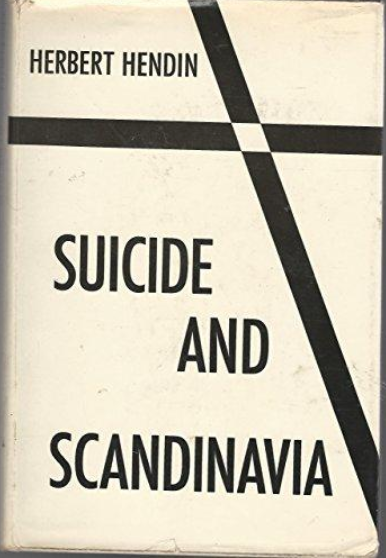‘Socialist’ suicide in Scandinavia: a historical view of a common myth
High rates of suicide are often connected with the Nordic countries and their apparently ‘socialist’ policies. Highlighting high suicide rates in Scandinavia can be traced back to at least the 1960s when foreign observers attempted to either undermine or legitimize the welfare states in Denmark, Norway and Sweden. These characterizations forced Scandinavian commentators to respond in diverse and interesting ways, sometimes invoking the spirit of regional solidarity against criticism from outside the region, other times acting competitively and combatively. In the process, the enduring myth of the extraordinarily ‘suicidal’ Scandinavians was born.

For the Scandinavian states in the twenty-first century, suicide plays a key role in their international image, despite a concurrent reputation for prosperity and stability. In this image, suicide is often purportedly linked with the political structures of the Nordic countries, especially the existence of a universal, redistributive welfare state, and is frequently juxtaposed with high rankings of international happiness surveys.
A New York Post article from 2015 drew upon this image to convince Americans about the undesirability of Scandinavian political lessons given the countries’ issues with alcoholism, use of anti-depressants, and suicide. This view posits suicide as the expected outcome when indivirodual freedom and initiative is sacrificed for social and economic security, making suicide a particularly Nordic phenomenon to the extent that these countries are still treated as being uniquely ’socialist’, often in contrast to the Anglo-American countries.
The circulation of this image has led commentators to frequently question the Nordic countries’ high rank in happiness surveys in the face of such seemingly massive unhappiness. In fact, most studies do not indicate a particularly strong tendency towards suicide in the Nordic region. In OECD data on suicide rates from 2014 to 2017, the Nordic countries appear around or under the median, with only Finland in the top 16, at number ten. In all five Nordic countries—with the possible exception of Iceland, where a small populace leads to a great deal of annual variance—suicide rates have fallen over the last 40 years.
These statistics have not unraveled the image of suicidal Scandinavians. Suicide is certainly an important public health issue in the Nordic region, especially for vulnerable groups like teenagers, the elderly, and LGBTQ+ individuals. Loneliness, often misunderstood and undiagnosed, and addiction to drugs and alcohol are furthermore major contributors to suicide rates and extremely complex to resolve. Yet, the struggles with stress, isolation, and addiction highlights that Scandinavian suicide cases are not special: the causes are often universal, and rates in these countries are neither particularly high nor low. However, the perpetual focus on these themes in a Nordic context suggests the image of Scandinavian suicide has taken on a reality independent of, and even in contrast to, actual conditions – a myth.
The myth of socialist suicide dates back at least a half century and was constructed through the Nordic countries’ interactions with other nations. Self-perpetuating and difficult to disprove completely, this myth has the ability to influence how outsiders view the Nordic region—as well as how Nordic citizens view themselves. Let us trace the roots of the myth of Scandinavian socialist suicide to the 1960s, as foreign observers attempted to either undermine or legitimize the Scandinavian countries and their burgeoning welfare states.
Reputation for suicide took hold in early 20
It was not until the twentieth century that the Scandinavian countries gained a reputation for being particularly suicidal. Before that, perceptions about the causes and acceptability of suicide of course fluctuated in the Nordic region over time. In the Norse eddas, the institution of honor regulated attitudes towards suicide, which was seen as an acceptable response to “the shame of not fulfilling an expected duty." Viking-era permissiveness contrasted with the Christian ethics of the Middle Ages, when suicide was considered a moral failing and socially unacceptable given the religious proscriptions against it. As elsewhere in Europe, Nordic society viewed suicide as self-murder and the result of spiritual and moral corruption, linking it with other elements of vice, most notably the consumption of alcohol. This conception of suicide as a wicked act encouraged nineteenth-century Scandinavian governments, along with governments in the rest of Europe, to begin measuring suicide rates as a means of assessing immoral activity. Suicide therefore remained illegal in the Nordic region until the mid-nineteenth century (and remained illegal in Finland until 1889). The censoring of suicide only began to change in the pre-modern era with the maturation of more scientific norms, which encouraged a view of suicide as the product of a medical disorder and consequently curable.
In the early twentieth century the Scandinavian countries would gain a reputation for being particularly suicidal. To some extent, this reflected reality as suicide rates increased in Scandinavia from the 1930s onwards and at a higher rate than other countries (at least in Denmark and Sweden). Culturally, the films of Ingmar Bergman in the 1940s and 1950s also gave international moviegoers access to bleak and pessimistic images of Sweden, which fit well with a supposed regional propensity to suicide. However, it was not until the mid-twentieth century that this image became politically charged.
Conservative backlash against the social democratic project in the mid-20th century
The early twentieth century witnessed the extensive development and alteration of Scandinavia’s international profile, particularly in the 1930s when American journalist Marquis Childs baptized it a “middle way” between capitalism and communism. While the depression-era desperation of the 1930s led many to fawn over the region’s economic and political stability, a counter-movement took hold in the 1950s, especially amongst conservative politicians and journalists. Scandinavian social services in this period began to resemble those in existence today, as social democratic governments created mandatory and voluntary programs that sought to equitably redistribute resources and ensure security in areas like housing, education, and pensions. In response, conservative rhetoric, both in and outside the region, increasingly characterized the Scandinavian countries as welfare states gone amok. According to such portrayals, the result was a rise in ‘welfare criminality’, meaning that the conformity and uniformity of the welfare state drove desperate citizens to acts of defiance: petty theft, alcohol and drug abuse, and suicide. The latter was justified by the higher recorded rates of suicide in countries like Denmark and Sweden—although notably not in Norway—than in the United States or the United Kingdom.
The rise of ‘socialistic’ suicide from late 1950
United States President Dwight Eisenhower  captured this new dystopic vision of Scandinavia during the final year of his presidency in 1960 while supporting his Vice President Richard Nixon’s presidential campaign. Decrying the dangers of the Democrats’ plans to expand government programs in an informal speech at the 1960 Republican convention, Eisenhower noted:
captured this new dystopic vision of Scandinavia during the final year of his presidency in 1960 while supporting his Vice President Richard Nixon’s presidential campaign. Decrying the dangers of the Democrats’ plans to expand government programs in an informal speech at the 1960 Republican convention, Eisenhower noted:
"I have been reading quite an article on the experiment of almost complete paternalism in a friendly European country. This country has a tremendous record for socialistic operation, following a socialistic philosophy, and the record shows that their rate of suicide has gone up almost unbelievably and I think they were almost the lowest nation in the world for [sic] that. Now, they have more than twice our rate." (Dwight D. Eisenhower, “Remarks at the Republican National Committee Breakfast, Chicago, Illinois.,” The American Presidency Project, July 27, 1960).
PICTURE: Dwight Eisenhower was US President from 1953 to 1961 and in 1960 linked suicide with socialism in an unspecified "European country". Photo: Dwight Eisenhower on Wikimedia, Public Domain.
This dystopic landscape, Eisenhower implied, awaited Americans if they strayed from the “middle of the road” into the “gutters” of socialistic experimentation, presumably by voting for John F. Kennedy. Although not the first to express a connection between suicide and the Scandinavian welfare state, Eisenhower’s prominent position ensured it became an international sensation.
Eisenhower’s statements led to some solidarity in the Nordic region, both in the way they refuted the president’s characterizations and in view of the attack being aimed broadly at the Nordic countries. When the Danish newspaper Berlingske Aftenavis put together a list of possible candidates that would fit the “friendly European country” on 29th July 1960 in an article called Eisenhower i Vinden (Eidenhower in the wind), it concluded that the president could be referring to Sweden, Denmark, Norway, or Iceland. It also highlighted a belief in the shared situations throughout the region. The indignation went to the top, as Swedish Prime Minister Tage Erlander defended the politics of Sweden, Denmark, and Norway, while Norwegian Prime Minister Einar Gerhardsen went on the attack by calling for an intervention by the US Congress.
However, the solidarity did not last long. Soon after the statement, reporters began comparing suicide rates and ’socialistic’ tendencies in the three Scandinavian countries to determine the true target of Eisenhower’s vitriol. The reports took on a flavor of attempting to find the mostsuicidal Scandinavians. Eventually, a type of consensus was reached in that Eisenhower was referring to Sweden, which led to frequent rebuttals from Swedish politicians and media figures for years afterwards (see Frederick Hale’s ‘Challenging the Swedish Social Welfare State: The Case of Dwight David Eisenhower’ in the journal Swedish-American Historical).
PICTURE: A still from the 1968 film Sweden: Heaven and Hell.
Socialist suicide would remain a compelling piece of imagery for foreigners seeking examples of the consequences of the welfare state. In a 2005 book, political scientist Richard Rose identified Eisenhower’s speech as a key moment for preventing the importation of Swedish-style social democracy to the USA. Part of the effectiveness of the suicide myth was its connections to a certain Nordic exoticism also circulating at the time. In 1968, the image captivated audiences watching the American trailer to the Italian mondo film Sweden: Heaven and Hell, which promised: “See the Stockholm strip, where Sweden’s liberated youth, bored with sex, bored with drugs, bored with life itself, drop out…for good.” The narration, accompanied by an image of a sprawling girl having ostensibly jumped to her death, bundled the suicide myth as part of the (outlandish) repercussions of a welfare state gone wild.
Blaming the mothers, Suicide and Scandinavia
 More nuanced voices also emerged during the 1960s, including those aiming to rebut the socialist suicide thesis. In 1964, Herbert Hendin, an American psychologist, published Suicide and Scandinavia: A Psychoanalytic Study of Culture and Character, which went on to become a foundational work on suicide in northern Europe. The first attempt at a comparative examination of the role of national characteristics in suicide across Scandinavia, Hendin intended his book to disprove that Scandinavian suicide was linked to “character defects” of social democracy as argued by “opponents of economic planning and social welfare measures.” (page 4) Instead, Hendin proposed that the Nordic states’ various psychosocial characteristics defined their proclivity to suicide. Danish mothers, having driven their husbands out of the child-rearing process, instilled guilt and dependency in their children, making Danes vulnerable to loss and fantasies of gratification after death. Swedes likewise suffered from “too much maternal control,” but also maternal rejection, as Swedish mothers demanded independent children in order to pursue their own careers (page 65 and 71). The result was emotional distance amongst Swedes, who turned to sexual contact to bridge the gap. Norway, which boasted a lower suicide rate, avoided such extremes by maintaining a “view of the woman’s role as that of a mother rather than a wife,” making for closer relationships, less dependency, and greater emotional freedom (page 102).
More nuanced voices also emerged during the 1960s, including those aiming to rebut the socialist suicide thesis. In 1964, Herbert Hendin, an American psychologist, published Suicide and Scandinavia: A Psychoanalytic Study of Culture and Character, which went on to become a foundational work on suicide in northern Europe. The first attempt at a comparative examination of the role of national characteristics in suicide across Scandinavia, Hendin intended his book to disprove that Scandinavian suicide was linked to “character defects” of social democracy as argued by “opponents of economic planning and social welfare measures.” (page 4) Instead, Hendin proposed that the Nordic states’ various psychosocial characteristics defined their proclivity to suicide. Danish mothers, having driven their husbands out of the child-rearing process, instilled guilt and dependency in their children, making Danes vulnerable to loss and fantasies of gratification after death. Swedes likewise suffered from “too much maternal control,” but also maternal rejection, as Swedish mothers demanded independent children in order to pursue their own careers (page 65 and 71). The result was emotional distance amongst Swedes, who turned to sexual contact to bridge the gap. Norway, which boasted a lower suicide rate, avoided such extremes by maintaining a “view of the woman’s role as that of a mother rather than a wife,” making for closer relationships, less dependency, and greater emotional freedom (page 102).
While Hendin disputed that the welfare state led to suicide, his book credited social and economic security with reinforcing suicidal tendencies. In Denmark, the expansive social programs fit with a Danish “desire to be taken care of,” leading to a lack of competitiveness and individual responsibility (pages 48-50). Meanwhile, Swedish government sponsored daycares contributed to the separation anxiety of its citizens, who lost contact with mothers pursuing individual freedoms. Hendin thus indirectly blamed the country’s initiative to bring women into the workforce for the suicidal tendencies of its citizens, even while expressing hope that these institutions could exist without the psychological cost (page 87).
Hendin’s book made a worldwide splash upon its release, winning the Association for Psychoanalytical Medicine’s 1964 book award, receiving favorable reviews in leading American newspapers, and inspiring other psychologists to test Hendin’s findings on the correlation of mothers’ care-giving with suicide. Even writers with diverging political convictions from Hendin, like conservative British writer Roland Huntford, came to use Suicide and Scandinaviato explain how the same society that led to the welfare state also pushed guilt upon its inhabitants.

PICTURE: Roland Huntford's The New Totalitarians which was influenced by Hendin's Suicide and Scandinavia.
Hendin’s book also left a mark on the self-understanding of Nordic citizens. The Norwegian translation of the book lured in readers with a provocative question on its front cover: “Why do we commit far fewer suicides than the Danes or the Swedes?” (Hvorfor begår vi langt færre selvmord enn danskene og svenskene?). Conversely, Danes responded negatively to Hendin’s assertions by trying to discredit Norwegian statistics. Leftist newspaper Information, for example, implied that Norway had as many suicides as Denmark but did not report them as such (Danmarks Rygte (Denmark’s reputation) published in Information on February 25, 1964). Similarly, on the political right, newspaper Berlingske Tidende claimed Danish citizens were in fact more satisfied with life than their Norwegian counterparts (see Litterært Selvmord (Literary suicide), March 25, 1964).
While national ego trumped regional fellowships, Danish journalists were also willing to turn their pens against the United States. Hendin’s inaccurate reporting, Informationconcluded, was due to Americans’ obsession with the Scandinavian countries and their welfare states. In any case, “well-disciplined and well-raised” Scandinavian children were surely better than those “small monsters” found in the US, as reported in Skyldfølelse Og Selvmord (Guilt and Suicide) in Aktuelt, January 11, 1961.
Scandinavian suicide today
The influences of the 1960s on the Scandinavian suicide myth reverberate today, both directly and indirectly, within the international reputations of the Nordic countries. Eisenhower’s condemnation of the socialist state is regularly included in portrayals of suicide in Scandinavia, while the region retains a ’socialist’ label amongst conservatives that fits unevenly at best. Meanwhile, the idea that career-driven women in Sweden contribute to suicide amongst their children remains a way of criticizing both the welfare state and Scandinavia’s emphasis on a dual-breadwinner household. And while international portrayals of socialist suicide usually no longer induce widespread rejoinders, the events of the 1960s remain a demonstration of the extent that foreign opinions can spark Scandinavian acts of solidarity—or disassociation.
Further reading:
- Evelyne Luef, 'Low Morals at a High Latitude? Suicide in Nineteenth-Century Scandinavia', Journal of Social History 46, 3, 2013, pp. 668–83.
- Frederick Hale, 'Challenging the Swedish Social Welfare State: The Case of Dwight David Eisenhower', Swedish-American Historical Quarterly 54, no. 1 (2003).
- Herbert Hendin, 'Suicide in Denmark', Columbia University Forum 4, 1961, pp. 26–32.